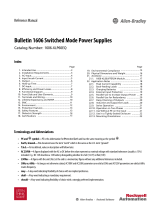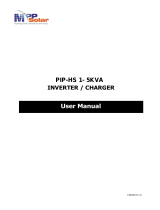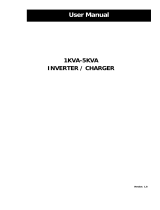Page is loading ...

RHINO PSL-24-BCM240 Battery Control Module
RHINO PSL-24-BCM240 BatteRy CONtROL MOduLe
IMPORTANT SAFETY INSTRUCTIONS
• Retain these instructions. This manual contains important
safety instructions.
• When replacing batteries, only use the same type of batteries
as described in the Specifications.
• Proper disposal of batteries is required. Refer to the relevant
local codes for disposal requirements.
• Switch main power off before connecting or disconnecting the
device. Danger of explosion!
• If the orange status LED is on steady, this indicates a failure
in the installation. In this case, do not turn on power supply
while the battery is connected. Danger of explosion!
• To guarantee sufficient convection cooling, keep a distance
of 20mm above and below the device as well as a lateral
distance of 5mm to other units. See Figure 4.
• Please note that the enclosure of the device can become very
hot depending on the ambient temperature and load of the
power supply. Risk of burns!
• The mains power must be turned off before connecting or
disconnecting wires to the terminals!
• Do not introduce any objects into the unit!
• Dangerous voltage present for at least 5 minutes after
disconnecting all sources of power.
• This is a built-in unit and must be installed in a cabinet or
room (condensation free environment and indoor location)
that is relatively free of conductive contaminants.
• CAUTION: FOR USE IN A CONTROLLED ENVIRONMENT.
READ INSTRUCTIONS BEFORE INSTALLING OR OPERATING
THIS DEVICE. KEEP FOR FUTURE REFERENCE.
3PET
E198298
Highlights & Features
• Suitable for 24V system up to 10A
• Zero switch over time from loss of DC input to battery
operation
• Built-in diagnostic monitoring for DC OK, Discharge and
Battery Fail by relay contacts
• Full power over entire operating temperature range from
-20°C to +60°C
• LED indicators for DC OK, Battery Charging, Battery
Discharging, Battery Fail and Battery Reverse Polarity
• High MTBF > 500,000 hrs. as per Telcordia SR-332
• Overvoltage, overcurrent, over temperature, short circuit
protections
• Powered systems may include unbuffered loads
General Description
The PSL-24-BCM240 battery control module is designed to
use in small cabinets where space is very critical. It requires
less installation space due to its flat body with depth of
only 55.6 mm, 71mm wide and 91mm tall. The tough plastic
case is flame retardant, certified to UL 94V-0 specification.
The module supports 24VDC systems with external battery
up to 12AH capacity and comes with contacts for battery
management signals and an LED indicator for battery status.
The highly efficient convection cooled design is certified to
major safety approvals including IEC/EN/UL 60950-1 for ITE
and UL 508 for Industrial, which allows the module to be used
reliably in most industrial applications.
Risk of electrical shock, fire, personal
injury or death.
1. Turn power off before working on the device.
2. Make sure the wiring is correct by following all
local and national codes.
3. Do not modify or repair the unit.
4. Use caution to prevent any foreign objects
from entering into the housing.
5. Do not use in wet locations.
6. Do not use the unit in area where moisture or
condensation can be expected.
Device description (Fig. 1)
Figure 1
(2) (3)
(1) (4)
(1) Input/Output/Battery terminal block connector
(2) Signal terminal block connector
(3) LED display status
(4) Universal mounting rail system
FOR TECHNICAL ASSISTANCE CALL 770-844-4200
1
1st Edition, Rev. A 1/2019

RHINO PSL-24-BCM240 Battery Control Module
Power Derating
Figure 6
*Note: When used with power supply of different ratings, must follow power supply derating curve
(or this derating curve, whichever is lower).
0
10
20
30
40
50
60
70
80
90
-20 -15 -10 -5 0 5 10 15 20 25 30 35 40 45 50 55 60 65
Percentage of Max Load (%)
Surrounding Air Temperature (°C)
32 41 50 68 77 86 95 104 113 122 131 140 149 158
Surrounding Air Temperature (°F)
-4 5 14 23
Power Derating Curve (Discharge Current)
0
10
20
30
40
50
60
70
80
90
100
110
-20 -15 -10 -5 0 5 10 15 20 25 30 35 40 45 50 55 60 65
Percentage of Max Load (%)
Surrounding Air Temperature (°C)
32 41 50 68 77 86 95 104 113 122 131 140 149 158-4 5 14 23
Figure 5
7mm
[0.28in]
1 2
In accordance with EN60950 / UL60950, flexible cables
require ferrules.
Use appropriate copper cables that are designed to sustain
operating temperature of at least 60°C/75°C for USA or at least
90°C for Canada.
Mounting
The unit can be mounted on 35mm DIN rails in accordance with
EN60715. For vertical mounting, the device should be installed
with Input/Output/Battery terminal block on the bottom.
Each device is delivered ready to install.
2
34
1
Figure 2
Snap on the DIN rail as shown in Fig. 2:
1. Pull the unit’s DIN rail latch DOWN.
2. Tilt the unit slightly upwards, hook the top end onto the DIN rail and
push downwards until stopped.
3. Position the bottom front end against the DIN rail.
4. Push the unit’s latch DIN rail UP to lock.
Dismounting
Figure 3
2
3
1
To uninstall:
1. Use a flat screwdriver to pull or slide down the latch as shown in Fig. 3.
2. Tilt the bottom part of the unit out.
3. Push the unit up and pull out from the DIN rail.
Connection
The terminal block connectors allow easy and fast wiring.
You
can use flexible (stranded wire) or solid cables as follows:
Electrical Connections and Wire Size
Stranded / Solid Torque
mm² AWG N·m lb·in
In/Out/Battery 2.1-3.3 14-12 0.62 5.4
Signal 0.21-3.3 24-12 0.62 5.4
The wires between the battery control module and battery
must not be longer than 2 x 2m (cord length 2m). For reliable
and shock proof connections, the wire stripping length should
be 7mm (see Fig. 5 (1)). Please ensure that wires are fully
inserted into the connecting terminals as shown in Fig. 5 (2).
Orientation
To guarantee sufficient convection cooling, keep a distance
of 20mm (0.79 inch) above and below the device as well as a
lateral distance of 5mm (0.2 inch) to other units.
20mm 20mm
Convection
Vertical Mounting
Figure 4
5mm
Input/Output
terminal block
at bottom
2
1st Edition, Rev. A 1/2019

RHINO PSL-24-BCM240 Battery Control Module
Buffering Time
0.5 1 2 3 4 5 6 7 8 9 10
0
200
400
600
800
1,000
1,200
1,400
1,600
Buffering Time (min)
Output Current (A)
Buffe ring Time
3.3 AH 7.5 AH 12AH
Figure 8
Buffering Time (minutes)
Output Current 3.3 AH 7.5 AH 12AH
0.5 A 400 900 1400
1A 180 398 654
2A 70 165 323
4A 28 72 160
6A 19 55 103
8A 11 22 49
10A 718 37
Signal wiring diagram
Contact relay rating: 1A/30VDC.
No polarity requirement.
DC
+‒
DC OK
1
2Voc
Isc
‒+
BCM Device
Discharging
3
4Voc
Isc
BAT Fail
5
6Voc
Isc
Battery
Figure 7
Signal wiring diagram
Status Indicators
BCM Status Relay Output Connector LED Display
Status
Discharging BAT Fail DC OK
Battery Fully Charged Open Open Closed Green LED On
Battery Charging Open Open Closed Green LED
Flashing
Battery Discharging*
(Buffering Mode) Closed* Open Closed Orange LED
Flashing
No Battery Connected Open Closed Open Red LED On
Output Shutdown Open Open Open No Light
* With output current 0.1 A to 10A.
Typical application notes
Figure 9
Battery
24V
+‒
+ ‒
Power
Supply
L N PE
BCM
+ ‒ ‒ + ‒ +
I/P O/P BAT
AC Input
Load 1
Unbuffered Load
‒+PE
Load 2
Buffered Load
+‒PE
Typical Application Notes
9.1 Provide backup power during AC source interruption or failure
9.2 Can be combined with redundancy module (PSB60-REM20S)
Battery
24V
+‒
+ ‒
Power
Supply 2
L N PE
BCM
+ ‒ ‒ + ‒ +
I/P O/P BAT
Load 1
Unbuffered Load
‒+
PE
Load 2
Buffered Load
‒+
PE
+ ‒
Power
Supply 1
L N PE
AC Input
Redundancy
Module
+ + ‒
+
OKOut
Vin2Vin1 Com
3
1st Edition, Rev. A 1/2019

RHINO PSL-24-BCM240 Battery Control Module
Technical Specifications
Input (DC)
Nominal input voltage 24VDC
Voltage range 24-28 VDC
Maximum input voltage < 33 VDC
Input current Charging Mode: 0.5 ± 0.1 A (25°C)
Discharging Mode: 10A Max.
Charging time < 30 hr ± 5 hr (25°C) for battery 24V/12AH
Efficiency Charging Mode: > 80.0%
Discharging Mode: > 99.0%
Output (DC)
Nominal output voltage 24VDC typ. (depends on Vin)
Discharging voltage 22-28 VDC
Maximum output voltage < 33 VDC
Output current 10A Max.
Derating Refer to Fig. 6
Component derating Vin = 28.0 VDC, Max. load
Short circuit / Overload Discharging Mode: Shutdown and no damage
Recommended Batteries
Battery types 24 V, VRLA
2 x 12V, VRLA
Battery capacity 3.3-12.0 Ah
Battery voltage range
23-28VDC (continuous operating),
33VDC Max (maximum voltage that will not cause damage to the unit)
20VDC Min (voltage level of battery to enable “BAT Fail” function)
Battery fuse
Auto 15A / 58V, MINI (Littelfuse) or similar in the battery path (protects the wires between the battery and the battery control module)
General Data
Type of housing Plastic (PC), enclosed
LED signals
Green LED On = Unit is fully charged
Green LED Flashing = Unit is charging
Orange LED Flashing = Unit is discharging
Red LED On = Battery fail (no battery is connected)
Orange LED On = Battery 24 V or DC 24 V reverse polarity
Signal relay contacts
DC OK = Contact is closed when battery is fully charged and the unit is ready to discharge/buffer.
DISCHARGING = Contact is closed when the unit is discharging/buffering with output current of 5mA-10 A.
BATTERY FAIL = Contact is closed when the battery fails to function.
MTBF > 500,000 hrs. as per Telcordia
Dimensions (L x W x H) 91mm x 71mm x 55.6 mm [3.58 in x 2.80 in x 2.19 in] (See www.AutomationDirect.com for complete engineering drawings.)
Weight 0.14 kg [4.9 oz]
Connection method Screw connection
Stripping length 7mm [0.28 in]
Operating temperature (surrounding air temperature) -20°C to +60°C [-4°F to +140°F] (Refer to Fig. 7)
Storage temperature -25°C to +85°C [-13°F to +185°F]
Humidity at +25°C, no condensation 5 to 95% RH
Vibration Operating: IEC60068-2-6, Sine Wave: 10Hz to 500Hz @ 19.6 m/s² (2G peak); 10 min per cycle, 60 min for all X, Y, Z directions
Non-Operating: IEC60068-2-6, Random: 5Hz to 500Hz (2.09Grms); 20 min per axis for all X, Y, Z directions
Shock (in all directions) Operating: IEC60068-2-27, Half Sine Wave: 4G for a duration of 22ms, 3 shocks for each 3 directions
Non-Operating: IEC60068-2-27, Half Sine Wave: 50G for a duration of 11ms, 3 shocks for each 3 directions
Pollution degree 2
Altitude (operating) 3000m
Certification and Standards
Electrical equipment of machines IEC60204-1
Electronic equipment for use in electrical power installations EN62477-1 / IEC62103-1
Safety entry low voltage PELV (EN60204), SELV (EN 60950)
Electrical safety (of information technology equipment) UL/C-UL recognized to UL60950-1 and CSA C22.2 No. 60950-1 (File No. E198298), CB scheme to IEC60950-1
Industrial control equipment UL/C-UL listed to UL508 and CSA C22.2 No.107.1-01 (File No. E197592)
CE In conformance with EMC directive 2014/30/EU and Low Voltage Directive 2014/35/EU
Component power supply for general use EN61204-3
Immunity EN55024, EN61000-6-2 (EN61000-4-2, 3, 4, 5, 6, 8)
Emission EN55032, EN55011
3PET
E198298
RoHS Compliant Yes
Safety and Protection
Isolation voltage:
Input & Output / PE
Signal / PE
Input & Output / Signal
1kVAC
1kVAC
1kVAC
Polarity protection Yes
Protection degree IP20
Safety class Class III
4
1st Edition, Rev. A 1/2019

RHINO PSL-24-BCM240 Battery Control Module
Troubleshooting
Troubleshooting
Problem Possible Cause Suggestion
Orange LED is ON Steady Input connection or battery connection is
reverse polarity.
Check polarity of input connection and battery
connection and make corrections.
BCM does not operate in charging mode after input is
applied
Input wiring is open or no input voltage to
the BCM is supplied. Check wiring and voltage of input supply.
Internal fuse is opened. Replace the battery control module.
BCM does not operate in buffering mode after input
voltage drops
Battery wiring is not connected or is
opened.
Check battery wiring and compare with Typical
Application Notes in this BCM datasheet. Make
corrections as needed.
Battery has not had enough time to
be charged and it is still below the
continuous operating voltage range.
Check battery voltage and compare with minimum
required battery voltage provided in this BCM
document.
Protection mode enabled.
Check for overvoltage, overcurrent, over
temperature, or short circuit condition, and
correct.
6
1st Edition, Rev. A 1/2019
/





